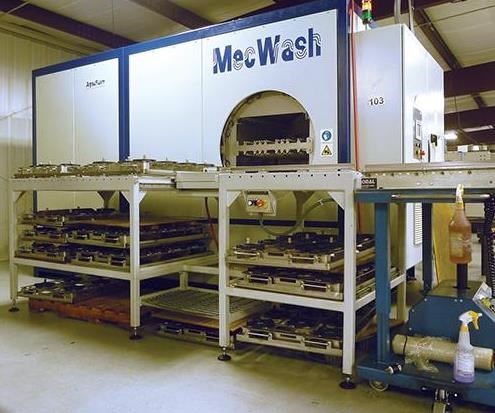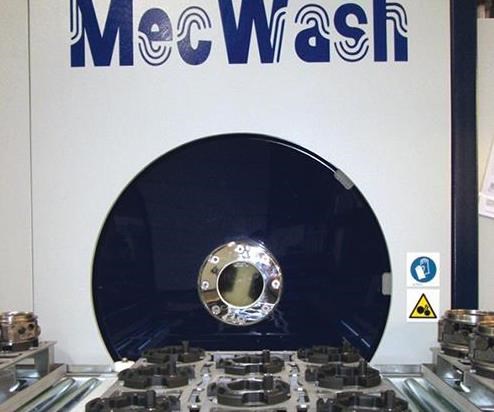Parts Cleaning: Aqueous System Handles Tighter Cleaning Specs for Intricate Plans
Where 10 years ago, particle sizes of 1,000 microns captured in a millipore patch test might have been acceptable, today heavy equipment OEMs commonly demand maximum particle sizes of 600 microns or less.

Original equipment manufacturers in the heavy equipment industry continue to demand ever more stringent cleanliness requirements from their suppliers. Where 10 years ago, particle sizes of 1,000 microns captured in a millipore patch test might have been acceptable, today heavy equipment OEMs commonly demand maximum particle sizes of 600 microns or less. And where in years past, the gravimetric weight gain of particulate captured from the millipore test procedure may have had no defined limit, today that has completely changed. Now these same OEMs set gravimetric limits not to exceed 100 milligrams on components that are critical to the fuel, oil, and airflow inside of engines, pumps, and compressors. Tier 1 and 2 machining houses have had to respond accordingly.
Increasing Demands
The manufacturing and quality engineers at Stewart Manufacturing, a Hermansville, Michigan, machining house, found themselves in this exact situation recently when one of their best customers ratcheted up the cleanliness requirements for a family of cast iron turbo bearing housings that Stewart manufactures. The tighter cleanliness specifications meant that particles over 500 microns were no longer acceptable, gravimetric weight gain would be restricted to 25 milligrams, and no amount of abrasive material—in this case residual honing grit—would be allowed at all.
Before the customer made these changes to its cleanliness requirements, Stewart would clean the turbo bearing housings (after they were honed) using a 15-minute cleaning cycle inside a spray cabinet washer. However, this cycle time was inexact because often the spray washer did not successfully clean the parts in a single cycle. Thus, the bearing housings were often rewashed in a second 15-minute process.
Recognizing that it frequently took two wash cycles to clean these housings in their spray cabinet and they were now faced with much more stringent cleanliness requirements, the engineers at Stewart understood that they would need to make a change to a high-performance cleaning system. They felt it would need to be able to flood every drilled passage of the various housings multiple times during a cleaning cycle and engage powerful ultrasonics to evacuate cast iron filings and all grit retained in the bearing housings after the honing process.

A New System
Stewart quickly began its search for a new cleaning system. “When an important customer is pleased enough with your finished product to give you increasingly more business, you don’t hesitate to dedicate the resources necessary to create a winning situation for both parties,” says Randy McLeod, Stewart’s vice president of manufacturing.
Fortunately, they didn’t have to look far for a suitable system, checking first with the customer itself. “As for the more rigorous cleanliness standards, our belief was that our customer was probably achieving them inside their own manufacturing operations, so we inquired with our contacts there.”
Pleased with its own 2012 purchase of a MecWash Systems aqueous parts cleaning system, the customer suggested that Stewart research this line of parts washing equipment. Initially, Stewart believed a MecWash Midi would achieve its cleaning throughput and cleanliness requirements.
The Midi is a versatile, aqueous single-chamber rotational cleaning system that features ultrasonic flood wash and rinse, immersion wash and rinse, spray wash and rinse, hot air dry, and vacuum dry to eviscerate any retained water in small blind holes of components with more complex geometries. Stewart’s family of cast iron bearing housings did have blind holes, so a vacuum dry function would be an important part of an effective cleaning process.
As consideration of the Midi continued, however, Stewart’s business with its customer continued to expand. In the end, because of this additional business, Stewart decided to purchase a MecWash Maxi. The Maxi retains all of the performance of the Midi, but is constructed with a much larger cleaning chamber that measures 24 inches width and height by 40 inches long. This larger design allowed Stewart to accommodate its expanding production requirements.
To successfully clean these cast iron bearing housings, holding them firmly in place during the full rotation throughout the entire cleaning cycle was critical. To meet this requirement, MecWash Systems designed four different purpose-built holding fixtures that would securely retain bearing housings measuring several different diameters.
The Maxi was installed at the Stewart facility in the spring of 2015. Since that time, it has been cleaning turbo bearing housings on every shift virtually non-stop.
For the smallest housing, the Maxi cleans 26 housings on two fixtures per 15-minute cleaning cycle. For the largest, the system cleans 12 housings on two fixtures per 15-minute cycle. Across the different housing diameters, the system can clean an average of 84 turbo bearing housings per hour. “Because of the Maxi’s high performance and huge cleaning capacity, we were able to offer Stewart a system that could both achieve its customer’s cleanliness requirements and surpass Stewart’s desired goal to be able to clean up to 80 turbo bearing housings per hour,” says Bill Westbrook, MecWash System’s North American operations director.
For information from MecWash Systems, call 440-564-7894 or visit mecwash.com.
Related Content
Pretreatment of Black Oxide
Having issues achieving a consistent color with the application of black oxide? Start by looking at your pretreatment. Connor Callais of Hubbard-Hall offers advice for troubleshooting your black oxide process.
Read MoreFrom Drain to Gain with Smart Wastewater Recovery
Incorporating digital monitoring to maximize performance.
Read MoreCorrosion Resistance Testing for Powder Coating
Salt spray can be useful to help compare different pretreatment methods and coatings but it does not tell us much about the corrosion resistance of a part over time in the field. Powder coating expert Rodger Talbert offers insights into how to get a better idea of how to improve a part’s corrosion resistance in the real world.
Read MoreTesting Safe Alternative Conversion Coatings
A joint test protocol was developed by a hex chrome-free consortium to best evaluate the most recent commercially available alternative conversion coatings. This article reveals the findings.
Read MoreRead Next
Delivering Increased Benefits to Greenhouse Films
Baystar's Borstar technology is helping customers deliver better, more reliable production methods to greenhouse agriculture.
Read MoreA ‘Clean’ Agenda Offers Unique Presentations in Chicago
The 2024 Parts Cleaning Conference, co-located with the International Manufacturing Technology Show, includes presentations by several speakers who are new to the conference and topics that have not been covered in past editions of this event.
Read MoreEpisode 45: An Interview with Chandler Mancuso, MacDermid Envio Solutions
Chandler Mancuso, technical director with MacDermid Envio discusses updating your wastewater treatment system and implementing materials recycling solutions to increase efficiencies, control costs and reduce environmental impact.
Read More






















